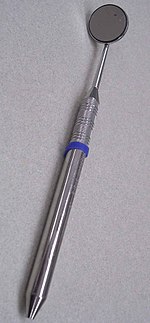Dental instruments are the tools that dental professionals use to provide dental treatment. They include tools to examine, manipulate, restore and remove teeth and surrounding oral structures.
Standard instruments
Standard instruments are the instruments used to examine, restore and extract teeth and manipulate tissues.
Examination instruments
These tools allow the dental professional to manipulate tissues, to allow better visual access during treatment or during dental examination.
Mirror
Dental mirrors are used by the dentist or dental auxiliary to view a mirror image of the teeth in locations of the mouth where visibility is difficult or impossible. They also are useful for reflecting light onto desired surfaces, and with retraction of soft tissues to improve access or vision.
Probes
Retractors
Local anesthesia
Dental anesthesia and Dental syringe.
Dental drills
High speed air driven, slow speed, friction grip, surgical hand piece. Straight handpiece with a sharp bur.
Burs
Dental Burs cutting surface are either made of a multifluted tungsten carbide, a diamond coated tip or a stainless steel multi fluted rosehead. There are many different types and classifications of burs some of the most common are: the round bur (sizes ¼ to 10) or inverted cone (sizes 33½ to 90L) Burs are also classified by the type of shank. For instance a latch type, or right angle bur is only used in the slow speed handpiece with contra-angle attachment. Long shank or shaft is only used in the slow speed when the contra-angle is not in use, and finally a friction grip bur which is a small bur used only in the high-speed handpiece.
There are many bur shapes that are utilized in various specific procedures.
Operative burs
Flat fissure, pear-shaped, football, round, tapered, flame, chamfer, bevel, bud bur, steel, inverted cone, diamond, brown stone, greenstone
Restorative instruments
Excavators
- spoon excavator: which is used to remove soft carious decay
- half hollenbach: this instrument is usually used to test for overhangs or flash
- Chisels:
Straight - bevels the cavosurface margin and used in 3, 4 and 5 classifications of cavities on the maxillary. Wedelstaedt - only used in the anterior for classes 3, 4 and 5 as well. Bin Angle - this is held in a pen grasp and used for class 2 maxillary only.
Burnishers
- flat plastic, ball burnisher, beavertail burnisher, cone burnisher, J Burnisher, pear shaped burnisher
Pluggers
- Amalgam plugger, 49 plugger
Periodontal scalers
Curettes
Universal curettes, Gracey curettes resr
Ultrasonic scalers
Prosthodontic instruments
Removable prosthodontics
Spatula, Fox plane, Willis Gauge, Bunsen burner, wax knife, Le cron, calipers
Extraction/surgical instruments
Dental forceps
Upper Universals, Upper Universal Fine, Lower universals, Upper Canine, Upper straight long, Upper straight short, Upper right molar, Upper left molar, Upper wisdom tooth, Greyhound, Root, Bayonet
Elevators
Narrow and wide straight and curved luxators, Couplands, Warrick James, Cryer, periosteal elevator, root-tip pick, potts, Cogswell-A.
Chisels
Osteotome
Orthodontic instruments
Ligature
distal end cutters,weingarts
Endodontic instruments
K-file, hedstrom file, gates glidden, finger spreader, Lentulo spiral, straight probe, apex locator, microscope, plugger WHT .





wow nice i really thanx you have put nice information in yours site...
ReplyDeletedental instruments